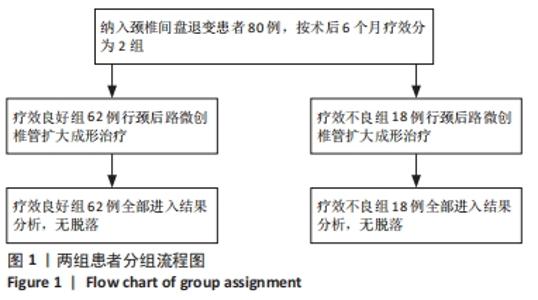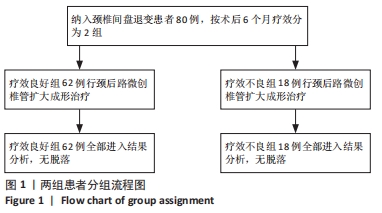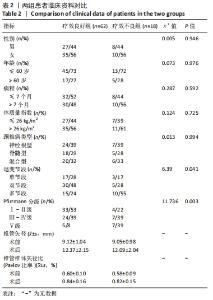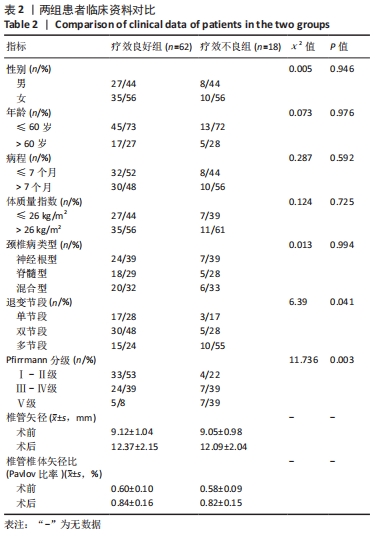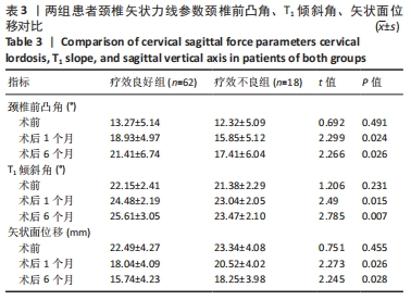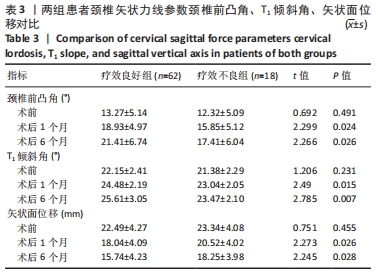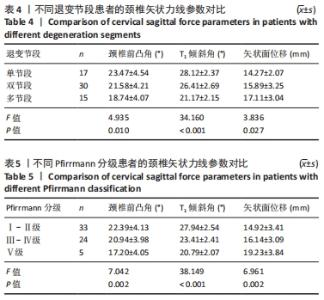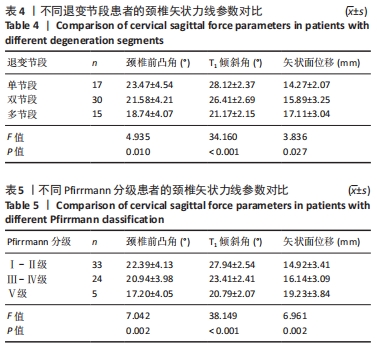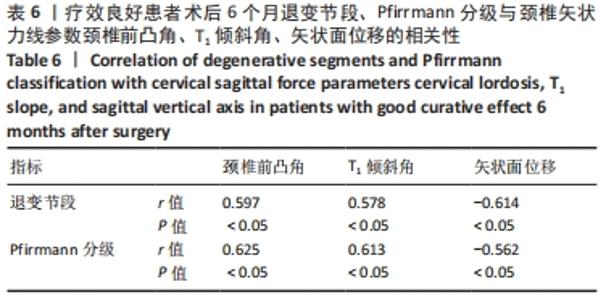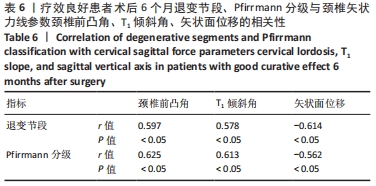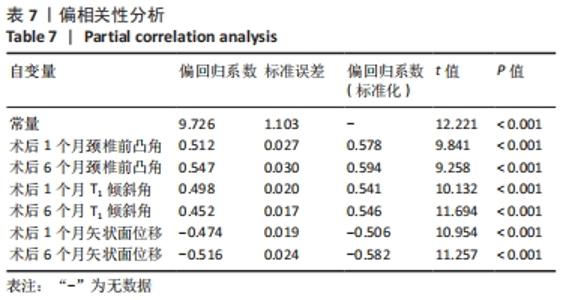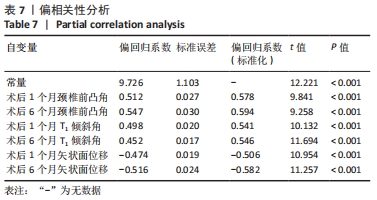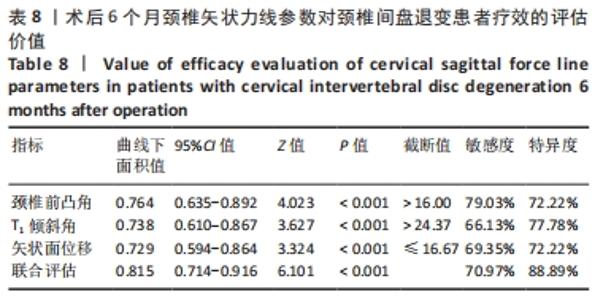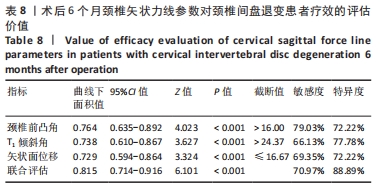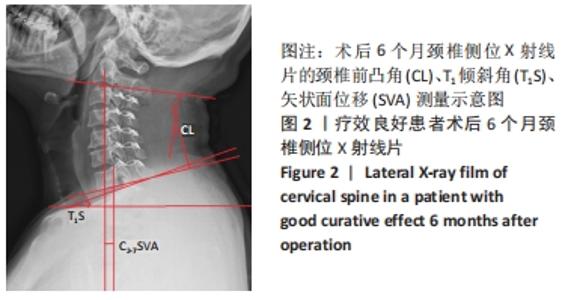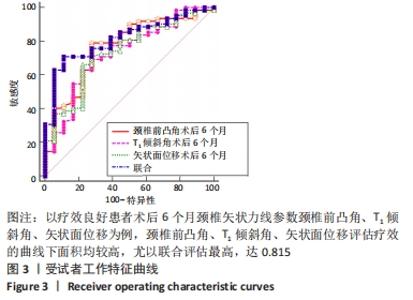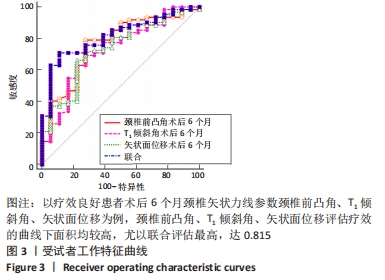[1] LEE CH, HEO SJ, PARK SH, et al. The Functional and Morphological Changes of the Cervical Intervertebral Disc after Applying Lordotic Curve Controlled Traction:A Double-Blind Randomized Controlled Study. Int J Environ Res Public Health. 2019;16(12):2162.
[2] 丁吉,程招军,张黎龙,等.2种固定方式对短节段颈椎前路椎间盘切除融合术后颈椎矢状位参数变化的影响[J].天津医药,2020, 48(8):736-740.
[3] XU C, WANG R, LI J, et al. Intervertebral-spreader-assisted anterior cervical discectomy and fusion prevents postoperative axial pain by alleviating facet joint pressure. J Orthop Surg Res. 2022;17(1):91.
[4] TAMAI K, BUSER Z, PAHOLPAK P, et al. Can C 7 Slope Substitute the T 1 slope? An Analysis Using Cervical Radiographs and Kinematic MRIs. Spine. 2018;43(7):520-525.
[5] 唐烨,卢圆圆,贾真.脊柱-骨盆矢状面参数对腰椎间盘手术临床疗效的预测价值[J].中国现代医学杂志,2020,30(13):80-83.
[6] 中华外科杂志编辑部.颈椎病的分型、诊断及非手术治疗专家共识(2018)[J].中华外科杂志,2018,56(6):401-402.
[7] 宋卿鹏,田伟,何达,等.颈椎人工间盘置换术对颈椎退行性疾病的长期疗效观察[J].中华医学杂志,2018,98(17):1358-1363.
[8] TAMAI K, GRISDELA PJR, ROMANU J, et al. The Impact of Cervical Spinal Muscle Degeneration on Cervical Sagittal Balance and Spinal Degenerative Disorders. Clin Spine Surg. 2019;32(4):E206-E213.
[9] 李祖昌,蒋继乐,何达,等.颈椎矢状面平衡参数与颈椎手术关系的研究进展[J].中华骨科杂志,2021,41(8):532-540.
[10] 彭兵,程招军,李巍,等.颈椎后路单开门椎管成形术后颈椎矢状位的影像学变化[J].中国中医骨伤科杂志,2018,26(1):39-42,47.
[11] YANG X, DONK R, BARTELS RHMA, et al. Comparing Heterotopic Ossification in Two Cervical Disc Prostheses. Spine. 2020;45(19):1329-1334.
[12] 黄清奇,刘少强,梁珪清.颈椎矢状面力线与平衡的临床意义研究进展[J].中华外科杂志,2018,56(8):634-638.
[13] WANG X. T1 Slope in the Cervical Spine Magnetic Resonance Imaging: A Novel Concept. Asian Spine J. 2018;12(1):193.
[14] XING R, ZHOU G, CHEN Q, et al. MRI to measure cervical sagittal parameters: a comparison with plain radiographs.Arch Orthop Trauma Surg. 2017;137(4):1-5.
[15] 李翔宇,孙祥耀,鲁世保,等.颈椎矢状位序列参数对脊髓型颈椎病临床疗效的影响[J].中国骨与关节杂志,2018,7(11):867-872.
[16] 郭山强,王帅,盖利,等.颈椎前路椎间盘切除融合术后颈椎矢状位参数变化及其对临床疗效的影响[J].骨科,2019,10(1):8-13.
[17] 杨建伟,赵杰.颈椎矢状力线和颈椎间盘退变的关系[J].中国矫形外科杂志,2019,27(15):1370-1374.
[18] 唐翎,仲建全,巫恒平,等.青年下腰痛患者腰椎生理曲度与腰椎间盘Pfirrmann分级的相关性研究[J].实用放射学杂志,2018,34(12): 1912-1914,1928.
[19] 裴瑞琪.经皮椎间孔镜技术治疗腰椎间盘突出症疗效与腰椎间盘退变的相关性分析[D].承德:承德医学院,2020.
[20] 张素芳,张炳,王国华,等.3.0 T MR T1ρ及T2 mapping在颈椎间盘退行性变中的应用研究[J].中华放射学杂志,2019,53(8):732-736.
[21] AŞKIN A, BAYRAM KB, DEMIRDAL ÜS, et al.The evaluation of cervical spinal angle in patients with acute and chronic neck pain. Turk J Med Sci. 2017;47(3):806-811.
[22] 王广超,李永军,吕志刚.颈椎间盘退变程度与颈椎矢状力线参数的相关性分析[J].颈腰痛杂志,2020,41(1):32-35.
[23] URBANSCHITZ L, MERAT S, BENSLER S, et al. Cervical disc degeneration reduces distance between vertebral artery and surgical landmarks. Clin Neurol Neurosurg. 2021;200:106332.
[24] XU C, YIN M, MO W. An independent agreement study of modified Pfirrmann grading system for cervical inter-vertebral disc degeneration in cervical spondylotic myelopathy. Br J Neurosurg. 2020:1-5.
[25] HOLLENBERG AM, MAQSOODI N, PHAN A, et al. Bone morphogenic protein-2 signaling in human disc degeneration and correlation to the Pfirrmann MRI grading system. Spine J. 2021;21(7):1205-1216.
[26] OH CH, KIM DY, JI GY, et al. Cervical arthroplasty for moderate to severe disc degeneration: clinical and radiological assessments after a minimum follow-up of 18 months--Pfirrmann grade and cervical arthroplasty. Yonsei Med J. 2014;55(4):1072-1079.
[27] WANG X, MENG Y, LIU H, et al. Association of cervical sagittal alignment with adjacent segment degeneration and heterotopic ossification following cervical disc replacement with Prestige-LP disc. J Orthop Surg (Hong Kong). 2020;28(3):2309499020968295.
[28] XING R, LIU W, LI X, et al. Characteristics of cervical sagittal parameters in healthy cervical spine adults and patients with cervical disc degeneration. BMC Musculoskelet Disord. 2018;19(1):37.
[29] LEE HJ, JEON DG, PARK JH. Correlation between kinematic sagittal parameters of the cervical lordosis or head posture and disc degeneration in patients with posterior neck pain. Open Med (Wars). 2021;16(1):161-168.
|
